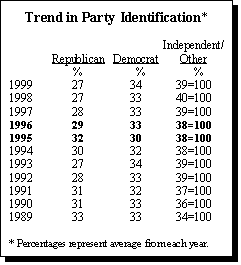Democrats Make Gains
 The Democratic Party now enjoys as big an advantage over the Republican Party as it has in at least a decade, though recent shifts in party affiliation have not been dramatic. In 1999, 34% of Americans identify themselves as Democrats, 27% say they are Republicans and 39% are Independent. In 1994, the parties were closer to parity: 32% Democrat, 30% Republican. And in 1989, equal percentages of Americans identified themselves with the two major parties (33% for each).1
The Democratic Party now enjoys as big an advantage over the Republican Party as it has in at least a decade, though recent shifts in party affiliation have not been dramatic. In 1999, 34% of Americans identify themselves as Democrats, 27% say they are Republicans and 39% are Independent. In 1994, the parties were closer to parity: 32% Democrat, 30% Republican. And in 1989, equal percentages of Americans identified themselves with the two major parties (33% for each).1
Looking at the trend in party affiliation over the last 10 years, the imprint of Newt Gingrich’s 104th Congress is clear. At only one point during the last decade did Republicans outnumber Democrats; that was in 1995 when 32% of Americans aligned themselves with the GOP and 30% considered themselves Democrats. This small Republican advantage came on the heels of the party’s historic takeover of the House of Representatives and in the midst of the party leadership’s ambitious legislative agenda. The advantage quickly shifted back to the Democrats by 1996 — after the GOP was blamed for an unpopular government shutdown, and President Clinton coasted to an easy re-election over GOP challenger Bob Dole. By 1997, Democrats outnumbered Republicans by 33% to 28%.
The Republican revolution had a much more significant and long-lasting impact on party affiliation than did the GOP’s unpopular efforts to impeach Clinton. Party affiliation figures have remained remarkably stable since the historic events of 1998 and early 1999.
But Does it Matter?
It is unclear at this point how the Democratic advantage in terms of party affiliation will impact the 2000 presidential election. In spite of the fact that significantly more Americans consider themselves Democrats than Republicans, George W. Bush consistently leads Al Gore in the presidential matchup.


